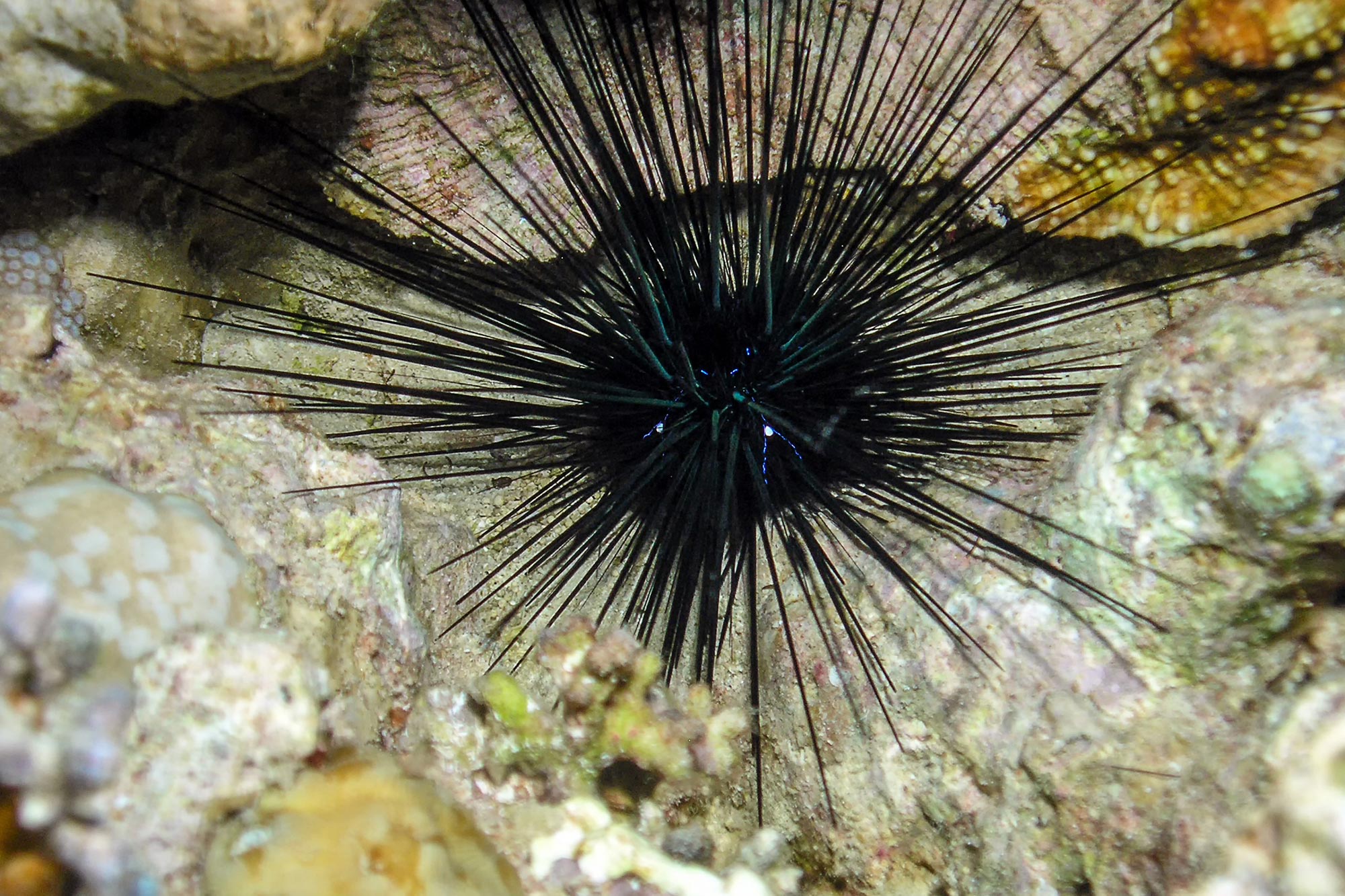
A single-celled organism, scuticociliate, has been identified as the cause of the 2022 mass death of long-spined sea urchins in the Caribbean and east coast of Florida. These urchins are essential to the health of coral reefs, and the discovery raises questions about the presence of ciliates, their growth conditions, and their potential impact on other species. Photograph of the long, spiny sea urchin (Diadema antillarum).
The long-spined sea urchin’s mass death—a loss that threatens the health of coral reefs from the Caribbean to Florida’s east coast—was caused by a single-celled organism called a ciliate.
The hunt for a killer has ended in 2022 that wiped out long-spined sea urchins in the Caribbean and along Florida’s east coast. A team of researchers organized by Mia Breitbart, Distinguished University Professor in the University of South Florida’s College of Marine Sciences, has identified a single-celled organism called a ciliary as the cause of massive death to a marine animal vital to coral reef health.
Their findings are published April 19 in the journal Nature
Ciliate culture viewed under the microscope. Credit: Mya Breitbart USF College of Marine Science
“We’re beyond thrilled to get to the bottom of the 2022 mystery and a bit stunned we did it so quickly,” said Breitbart, senior author on the Science Advances study and an expert in marine genomics. “We had a great team in place and the tools needed to do the ocean science equivalent of a forensic investigation.”
Ciliates are microscopic organisms covered in hair-like structures called cilia that help them move and eat. They are found almost anywhere there is water and most are not disease-causing agents. However, this specific species of ciliate – called a scuticociliate – has been implicated in die-offs of other marine species, such as sharks, in the past.

Photo compilation showing the same sea urchin before and after infection with the ciliate in the USF aquarium research facility. Credit: Makenzie Kerr USF College of Marine Science
Examining urchins collected from 23 sites in the Caribbean, the research team used a series of techniques to confirm the source of the die-off event.
After identifying the ciliate in every affected urchin specimen using genomic techniques, the team grew ciliates in the lab and performed infection experiments at the USF College of Marine Science. When the pathogen was introduced to otherwise healthy urchins in an aquarium tank, the urchins died within a few days – replicating what was taking place in the ocean and confirming the ciliate as the disease source.

DaSc-affected sea urchin, Aruba, August 2022. Credit: Ian Hewson Cornell University
“We’re excited to share this information with everyone, from reef managers to additional scientists so we can explore it further and try to stop its spread,” Breitbart said.

Mya Breitbart (USF) viewing the ciliate culture by microscopy. Credit: Makenzie Kerr USF College of Marine Science
The long-spined sea urchins inhabit shallow tropical waters and feed on algae that would otherwise destroy a reef. They began to lose their spines within days of contracting an unknown disease and died in droves starting in January 2022.
A similar die-off event took place in the early 1980s, which wiped out 98 percent of the long-spined sea urchin population. The culprit of that die-off remains a mystery.
Breitbart first got the call about the unfolding die-off at the end of March 2022. She immediately assembled a team consisting of Ian Hewson, lead author on the publication and a marine ecologist at Cornell University; Christina Kellogg, a microbiologist from the U.S. Geological Survey in St. Petersburg, Fla. who has worked extensively on coral reef diseases; and USF graduate student Isabella Ritchie.
“At the time, we didn’t know if this die-off was caused by pollution, stress, something else – we just didn’t know,” said Hewson, an expert in diseases that cause mass die-offs of sea stars, who flew from New York to the Caribbean Islands to observe the situation.
Even with the source of the mysterious die-off uncovered, questions still remain. For example:
- Is this ciliate new to the area, or was it there prior to the die-off?
- If it has been there, what environmental conditions favored its growth and why did it infect the urchins?
- Can it affect other species of urchins?
“One theory we have is that the ciliate grew well under the high productivity conditions observed in the Caribbean when it first started to fade,” Kellogg said. “We’re also curious about the fact that there’s some overlap in some of the geographic areas where this extinction occurred and where coral reefs are declining due to stony coral tissue loss disease.”
Reference: “Scuticocylate Agent Causes Mass Mortality of Diadema Antillarum in the Caribbean Sea” By Ian Hewson, Isabella T Ritchie, James S Evans, Ashley Alterra, Donald Berenger, Irene Bowman, Marilyn Brandt, Kayla A. Budd and Rolio A. Camacho, Thomas O. Cornwell, Peter D. Kimani A. Kitson-Walters, Patricia Kramer, Judith C.Lang, Harilaos Lessios, Lauren Liddy, David Marancik, Stephen Nimrod, Joshua T. Patterson, Marit Pistor, Isabel C. Romero, Rita Sellares-Blasco, Moriah LB Sevier, William Sharp, Matthew Souza, Andrina Valdez-Trinidad, Maren van der Laan, Brian Villanova-Cuevas, Maria Villalpando, Sarah de Von Huene, Matthew Warham, Tom Weyers, Stacy M. Yanong, Soumira Zambrano, Alise Zimmerman, Mia Breitbart April 19, 2023 Available here. Science advances.
DOI: 10.1126/sciadv.adg3200
The research was funded by the National Science Foundation, the Atkinson Rapid Response Center for Sustainable Futures, AGGRA, the National Oceanic and Atmospheric Administration, the National Fish and Wildlife Foundation, the Florida Keys Marine Preserve, and the Florida Fish and Wildlife Commission.

“Typical beer advocate. Future teen idol. Unapologetic tv practitioner. Music trailblazer.”








More Stories
Boeing May Not Be Able to Operate Starliner Before Space Station Is Destroyed
How did black holes get so big and so fast? The answer lies in the darkness
UNC student to become youngest woman to cross space on Blue Origin